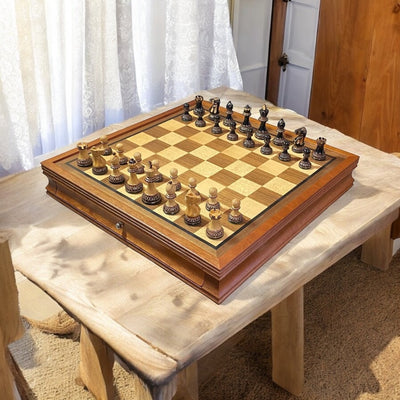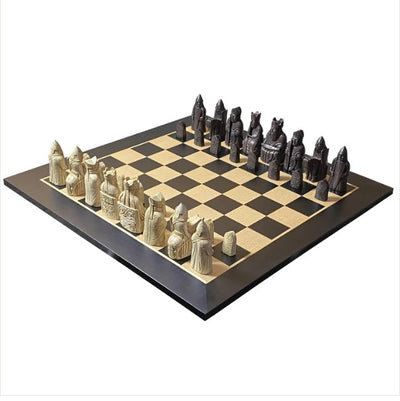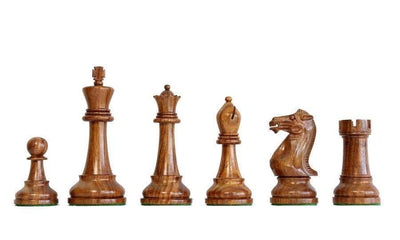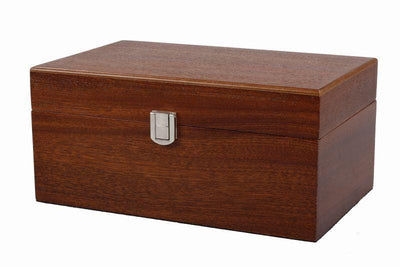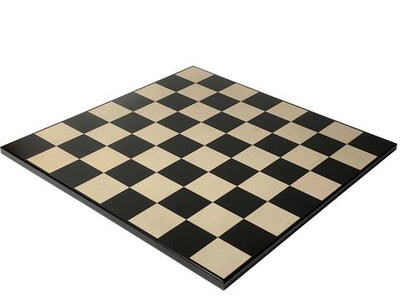The Best Chess Set Reproductions in the World
Over the last six months, for my great pleasure and much to my wife’s chagrin, I have purchased four sets of chessmen from Carl Miceli’s company, Official Staunton. Three of those sets are shown here in direct comparison on the same board. For the record, the board is a HOS green and beige leather board with 2-3/8” squares that was made in England for HOS around the time of purchase in 1999 or 2000. HOS no longer carries these boards, and no, I have no interest in selling it. Please don’t ask!
To dispel the misinformation that has been spread about Carl’s companies that has often cropped up in other threads, here is the breakdown as explained to me by Carl: Official Staunton is a direct to consumer retail company entirely owned by Carl. The English Chess Company wholesales chess sets to other retailers and does not sell directly to the consumer. This company is Carl’s in partnership with one other well known English player, businessman and journalist (not Ray Keene, thank God!) Chessmaze International is Carl’s umbrella company that includes his interests in the above, as well as his manufacturing concerns and partnerships with companies in India. The names are NOT interchangeable!
Earlier this spring, Carl came out with a reproduction of the 1849 Jaques set. Whether he was encouraged by the critical reception to CB’s version of the set designed by Alan Dewey and imperfectly implemented by VIk, or whether the introduction was altogether altruistic, only Carl knows. As it happened, Carl’s first attempt at the 1849 wasn’t perfect, either. While an excellent set, the denizens of this site offered advice to Carl about the perceived shortcomings. Some of the criticisms were that the queen was too large, with too pointed a crown, the bishop’s mitre was a little too angular, the king’s crown had too rounded a top, and the weighting of the set had too large a variation between the boxwood and the ebony pieces, which in some cases was noticeable during play. Carl took steps to correct the weighting issue, and the other issues spurred him to offer later in the summer the Official Staunton 1851 and 1870 sets. The 1851 and 1870 sets are almost identical, with the difference being in the knight, and in the material used. The three sets are shown below, with additional reference photos of an original 1849 set from the Crumiller collection and an alleged 1849 copy from Amritsar Ivory Works:
Now I give you the direct comparisons. All pictures showing the three sets in comparison are arranged in order: 1849, 1851, 1870. All three sets are made from the finest material, and are exquisitely finished to standards that compare excellently to the House of Staunton sets, which have become known as the standard of quality here in the United States. The 1849 and 1870 sets are boxwood and ebony; the 1851 set is boxwood and ebonized boxwood. I defy you to tell the difference. Only on the closest inspection is the slightly grainier ebony noticeable.
First, the kings:
All three sets are full club size sets with a 4.4” king. As you can see, the OS 1849 King has a rounded crown and a thinner upper ring between the shaft and the crown, as well as a slightly narrower shaft than the 1851 and the 1870. The bases of all three kings measure 1-7/8.” The weights are as follows, with separate weights for the boxwood and ivory sets, but only one for the 1851, which is all boxwood, albeit one side ebonized: 1849W, 104g, 1849B, 119g. The 1851 Kings weigh 130g, and the 1870W weighs 125g, the 1870B, 132g. All weights are of course for my reference sets only. Your mileage may vary. You will note that the 1849 set bears a greater resemblance to the AIW reference photo above, and the 1851 and 1870 sets adhere more closely to the Crumiller photograph. This holds true throughout the piece comparisons.
Next, the Queens:
The 1849 Queen stands 3-7/8” tall, with an 1-3/4” base, and has sharper points on her crown and a more rounded cap than the 1851 and 1870. The thinner upper ring between the shaft and the crown stays consistent throughout the set. In the 1851 and 1870 sets, the queens stand 3.5” tall, with a 1-3/4” base, and are almost a full inch shorter than the king. Weights are as follows: 1849W, 68g, the 1849B, 82g. The 1851 queens weigh 113g, the 1870W, 114g, the 1870B, 110g.
The Bishops:
The 1849 Bishops stand 3-1/2” tall, with a 1-1/2” base, and has a much more angular mitre than their 1851 and 1870 counterparts. All three mitre cuts are wide and nicely scooped. The 1851 and 1870 bishops stand slightly shorter at 3-1/8” tall, but maintain the same 1-1/2” base width. Weights are as follows: 1849W, 49g, 1849B, 58g. The 1851 bishops are 84g, the 1870W, 79g, 1870B, 80g.
The Knights:
The knights are all superlative examples of the woodcarver’s art, and all slightly different. The 1849 is reminiscent of a Cook type 2, according to the Camaratta classification, where the 1851 and 1870 seem to bear more resemblance to the Morphy knights. The 1849 and 1851 knights have solid eyes, where the 1870 knight has a pierced eye. Another difference is in the nostrils, which flare most in the 1870. The 1849 Knight stands tallest at 2-7/8” in height, with a 1-1/2” base, as opposed to the 1851 and 1870 knights, which stand a ¼” shorter at 2-5/8,” but have a slightly wider base at 1-5/8.” Weights are as follows: 1849W, 49g, 1849B, 53g. The 1851 knights weigh in at 82g, the 1870W, 80g, 1870B, 87g. The kingside knights are all stamped, but where the black 1849 knight and rook are stamped in white, the 1851 and 1870 kingside black pieces are stamped in red, which I believe is more original if harder to see.
The Rooks:
The 1849 rooks stand a solid 2-1/2” tall, with 1-1/2” bases. The 1851 and 1870 rooks are just a tad shorter at 2-7/16, but have a slightly wider base at 1-5/8.” This doesn’t sound like much of a size difference, but in fact the appearance is quite different, with the 1851 and 1870 rooks seeming a more squat if not almost stubby. All three versions have six low crenellations, rather than four or five. Weights are as follows: 1849W, 53g, 1849B, 60g. The 1851 rooks weigh in at 98g, and the 1870W are 96g, with the 1870B at 99g.
Lastly, the Pawns:
The 1849 pawns are almost as large as the 1849 rooks, standing 2-3/8” tall, with a 1-3/8” wide base. While not really evident from the angle of the photograph shown, the collar of the 1849 pawn seems just a little too prominent in practice, sort of like a pea on a plate. I am a little concerned that in the long term, chipping of the pawn collars might be a problem with this set. The 1851 and 1870 pawns are over a quarter of an inch shorter, at 2-1/16,” with a 1-1/4” base. The collars are just enough smaller than the 1849 not to seem unusually wide. The base of these pawns actually seems wider than the 1849 set, even though it’s not, due to the shorter stature of the pawns. While they are smaller, they are by no means out of proportion to the rest of the pieces in their respective sets. Weighting is as follows: 1849W, 34g, 1849B, 37g. The 1851 pawns weigh in at 49g, while the 1870W and 1870B both weighed 51g.
All three sets have impressed me with the overall quality of the craftsmanship. The weighting of the 1849 set surprised me, however. While the black king weighed in at a solid 119 grams, the white king was 15 grams lighter at 104g, and a 14 gram difference existed between the black and white queens. While a half an ounce in difference doesn’t sound like much, it is noticeable during play, and detracted from the experience. I was surprised when I checked the set, and found while checking with a magnet that the 1849 was weighted with either iron or steel, while the 1851 and 1870 sets are weighted with lead. Perhaps that is the source of the weighting differential. The 1849 set checks in at just over half the weight of the 1851 and 1870 sets.
In conclusion, all three of these sets are very competent attempts at a true reproduction of a 1849-51 Jaques Staunton set. The material used and craftsmanship are all top notch, and I feel are good value for the money, although others may feel differently. The sets are available online at officialstaunton.com. At current exchange rates, the 1849 Ebony set shown here is 349£, or approximately $540 US, while an ebonized version is available at 179£, or $277 US. The 1851 set is available in boxwood at 179£, or $277 US, and in antiqued boxwood at 199£, or $308 US. Lastly, the 1870 Ebony set is currently on sale for 150£, or $231.90 US, as the ebony, while of excellent quality, is not truly pure black and shows some brown striping under bright light. If you want a high quality set at a bargain price, the 1870 is the way to go.


